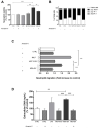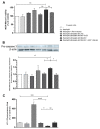Extracellular Vesicles Derived from MDA-MB-231 Cells Trigger Neutrophils to a Pro-Tumor Profile
- PMID: 35741003
- PMCID: PMC9221190
- DOI: 10.3390/cells11121875
Extracellular Vesicles Derived from MDA-MB-231 Cells Trigger Neutrophils to a Pro-Tumor Profile
Abstract
Immune system cells, including neutrophils, are recruited by the tumor microenvironment as a site of chronic inflammation and begin to favor tumor growth. Neutrophils present in the tumor site are called tumor-associated neutrophils (TAN) and can present two phenotypes: N1 (antitumor) or N2 (pro-tumor). Evidence shows the high capacity of immune system cells to interact with extracellular vesicles (Evs) released by tumor cells. Evs can modulate the phenotype of cells within the immune system, contributing to tumor development. Here, we investigated the role of MDA-MB-231-derived Evs upon the polarization of neutrophils towards an N2 phenotype and the underlying mechanisms. We observed that neutrophils treated with Evs released by MDA cells (MDA-Evs) had their half-life increased, increased their chemotactic capacity, and released higher levels of NETs and ROS than neutrophils treated with non-tumoral Evs. We also observed that neutrophils treated with MDA-Evs released increased IL-8, VEGF, MMP9, and increased expression of CD184, an N2-neutrophil marker. Finally, neutrophils treated with MDA-Evs increased tumor cell viability. Our results show that MDA-Evs induce an N2-like phenotype, and the blockage of phosphatidylserine by annexin-V may be an essential agent counter-regulating this effect.
Keywords: breast cancer; extracellular vesicles; inflammation; tumor-associated neutrophils.
Conflict of interest statement
The authors declare that they have no conflict of interest regarding the present study.
Figures





Similar articles
-
Melanoma-derived extracellular vesicles skew neutrophils into a pro-tumor phenotype.J Leukoc Biol. 2022 Mar;111(3):585-596. doi: 10.1002/JLB.3A0120-050RR. Epub 2021 May 27. J Leukoc Biol. 2022. PMID: 34043843
-
Obese adipose tissue extracellular vesicles raise breast cancer cell malignancy.Endocr Relat Cancer. 2020 Oct;27(10):571-582. doi: 10.1530/ERC-19-0507. Endocr Relat Cancer. 2020. PMID: 32738129
-
Extracellular Vesicles From Osteotropic Breast Cancer Cells Affect Bone Resident Cells.J Bone Miner Res. 2020 Feb;35(2):396-412. doi: 10.1002/jbmr.3891. Epub 2019 Nov 5. J Bone Miner Res. 2020. PMID: 31610048
-
Engineering and Targeting Neutrophils for Cancer Therapy.Adv Mater. 2024 May;36(19):e2310318. doi: 10.1002/adma.202310318. Epub 2024 Feb 20. Adv Mater. 2024. PMID: 38320755 Review.
-
The Functional Heterogeneity of Neutrophil-Derived Extracellular Vesicles Reflects the Status of the Parent Cell.Cells. 2020 Dec 18;9(12):2718. doi: 10.3390/cells9122718. Cells. 2020. PMID: 33353087 Free PMC article. Review.
Cited by
-
Tumor-derived extracellular vesicles: key drivers of immunomodulation in breast cancer.Front Immunol. 2025 Mar 4;16:1548535. doi: 10.3389/fimmu.2025.1548535. eCollection 2025. Front Immunol. 2025. PMID: 40103824 Free PMC article. Review.
-
Interleukin-8 in Colorectal Cancer: A Systematic Review and Meta-Analysis of Its Potential Role as a Prognostic Biomarker.Biomedicines. 2022 Oct 19;10(10):2631. doi: 10.3390/biomedicines10102631. Biomedicines. 2022. PMID: 36289899 Free PMC article.
-
Extracellular vesicles in neuroblastoma: role in progression, resistance to therapy and diagnostics.Front Immunol. 2024 Apr 9;15:1385875. doi: 10.3389/fimmu.2024.1385875. eCollection 2024. Front Immunol. 2024. PMID: 38660306 Free PMC article. Review.
-
Characterizing the Inflammatory Profile of Neutrophil-Rich Triple-Negative Breast Cancer.Cancers (Basel). 2024 Feb 10;16(4):747. doi: 10.3390/cancers16040747. Cancers (Basel). 2024. PMID: 38398138 Free PMC article.
-
Immunocytes in the tumor microenvironment: recent updates and interconnections.Front Immunol. 2025 Apr 14;16:1517959. doi: 10.3389/fimmu.2025.1517959. eCollection 2025. Front Immunol. 2025. PMID: 40297580 Free PMC article. Review.
References
Publication types
MeSH terms
LinkOut - more resources
Full Text Sources
Medical
Miscellaneous

